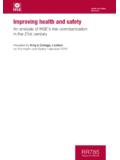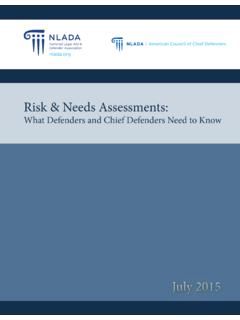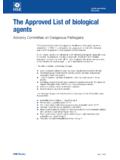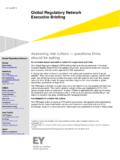Transcription of Port & Harbour Risk Assessment and Safety Management …
1 FINALGUIDELINESFORPort & Harbour RiskAssessment and SafetyManagement Systemsin New ZealandMARITIME Safety AUTHORITY OF NEW ZEALANDKia Maanu Kia OraMaritime SafetyKEEPING YOUR SEA SAFE FOR LIFE Disclaimer: All care and diligence has been used in extracting, analyzing and compiling this information, however, the Maritime Safety Authority gives no warranty that the information provide is without error Copyright Maritime Safety Authority 2004 ISBN Number Guidelines for Port & Harbour Risk Assessment and Safety Management Systems in New Zealand 2 Table of Contents 1.
2 INTRODUCTION .. 5 Risk Assessment .. 6 2. RISK Assessment CRITERIA AND STRUCTURING .. 9 Introduction .. 9 Port and Harbour Risk Assessment 9 Frequency 9 Consequence Criteria Across Four 10 Derived Risk 12 Using the Risk 13 Structuring the Risk Assessment .. 13 Defining the Skill 13 Defining the 14 3. STAGES OF A RISK Assessment - CARVING UP THE 16 Undertaking the Risk Assessment .
3 16 Stage 1 - Data Gathering and system Assessment .. 16 Stage 2 - Hazard Identification Process .. 17 One Person s Hazard is Another s Cause .. 18 Stage 3 - Risk Analysis .. 19 Stage 4 - Assessment of Existing Risk Management Strategies, Development of New Measures, Assessment of Control Adequacy 21 Control Adequacy 22 4. MANAGING AND TREATING THE RISK VIA THE PORT AND Harbour Safety Management 23 Introduction .. 23 The Port and Harbour Safety Management system .. 23 Safety Management system Challenges.
4 24 Introducing and Making Procedures work .. 26 The Key to the Safety Management Engine The Harbour Master .. 27 Safety Management system Review and Audit .. 28 GLOSSARY .. 29 Guidelines for Port & Harbour Risk Assessment and Safety Management Systems in New Zealand 3 ANNEX A .. A1 Supporting Notes to the Worked Example .. A2 Table A1: Derived Hazard List with Frequency and Consequence Scores .. A3 Table A2: Example of Ranked Hazards with Risk Matrix Scoring .. A9 A3 Pull-out for A14 ANNEX B ..B1 Table B1: Risk Control Referenced to Hazards in Annex A.
5 B2 ANNEX C .. C1 Figures Figure 1: Relationship between Risk Assessment and the Safety Management 6 Figure 2: Example Risk 8 Figure 3: Frequency Matrix for Use in Port and Harbour Risk Assessment .. 9 Figure 4: Consequence Matrix for use in Port and Harbour Risk 11 Figure 5: Risk Matrix for use in Port and Harbour Risk Assessment .. 12 Figure 6: Adequacy of Existing Controls .. 22 Figure 7: Components of a Safety Management system for a Port or Harbour .. 24 Figure 8: Conditions Increasing Likelihood of Error .. 26 Guidelines for Port & Harbour Risk Assessment and Safety Management Systems in New Zealand 4 Preface These guidelines are one of a series supporting the New Zealand Port & Habour Marine Safety Code.
6 They provide detailed and, in some cases, technical guidance relating to the specific measures, identified in that Code, that fall to regional councils, port companies and other participants to implement in fulfilment of their duties and exercise of powers under the law. The guidelines, as also the Code itself, are not statements and good practice intended to stand for all time. Rather, they are living documents to be revised in the light of the lessons drawn from experience, advances in technical knowledge and capability, and the ongoing imperative of continually improving Safety Management within our port and Harbour system .
7 As at August 2004, the Code is supported by Guidelines for Port & Harbour Risk Assessment and Safety Management Systems in New Zealand Guidelines for Providing Aids to Navigation in New Zealand Guidelines of Good Practice for Hydrographic Surveys in New Zealand Ports & Harbours Additional guidance documents are in preparation or planned. Support for participants when considering the relevance of various metrological and hydrographic occurrences will be available in a report on environmental factors affecting safe access and operations in ports and harbours, due to be published in September 2004.
8 During the next year, MSA with be working with participants to produce guidelines for vessel traffic services as well as standards for harbourmasters. It is further proposed to adopt an existing standard for the use of tugs in ports published by the Nautical Institute. Comments and queries relating to these guidelines, as well as any questions concerning the New Zealand Port & Harbour Marine Safety Code should be addressed to Nautical Analyst Maritime Safety Authority PO Box 27006 Wellington e-mail phone 04 473 0111 (toll free 0508 225522), fax 04 494 1263 Copies of the guidelines and the Code are available from MSA free of charge.
9 Electronic versions are available from Russell Kilvington Director of Maritime Safety August 2004 Guidelines for Port & Harbour Risk Assessment and Safety Management Systems in New Zealand 5 Introduction This document provides guidance to those responsible for navigational Safety within designated Harbour areas. It is designed to provide important assistance to Regional Councils and Port Companies when undertaking a risk Assessment of navigational activities and installing a Safety Management system in accordance with the requirements of the New Zealand Port & Harbour Marine Safety Code (the Code).
10 The focus of these guidelines is on risk Assessment and Safety Management to improve Safety of vessel or craft movement and navigation within a Harbour area as defined by the Code. The definition of a Harbour , Port, Port Company and Regional Council is provided in the Code and therefore not repeated here, although a glossary of relevant terms for this document is provided at the end of this document. The detail to which these guidelines are followed needs to be assessed at the time of Code Application Assessment as defined by the Code. For example, there may be some waterways where a truncated or high-level risk Assessment process may be required.














